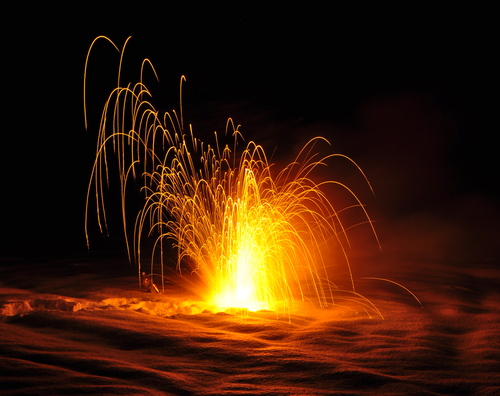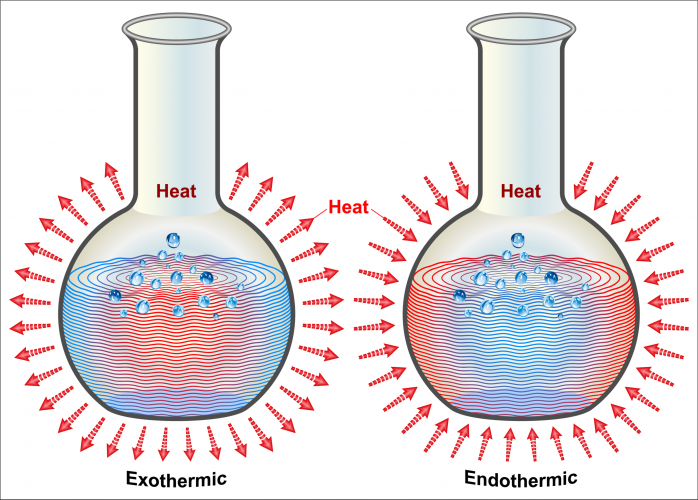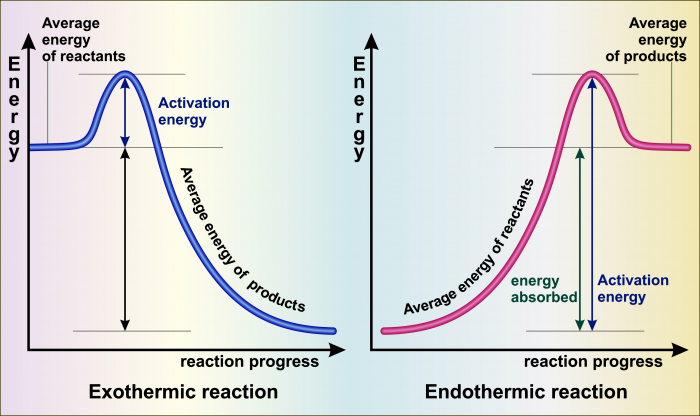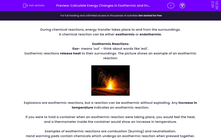During chemical reactions, energy transfer takes place to and from the surroundings.
A chemical reaction can be either exothermic or endothermic.
Exothermic Reactions
Exo- means 'out' - think about words like 'exit'.
Exothermic reactions release heat to their surroundings. The picture shows an example of an exothermic reaction:

Explosions are exothermic reactions, but a reaction can be exothermic without exploding. Any increase in temperature indicates an exothermic reaction.
If you were to hold a container when an exothermic reaction were taking place, you would feel the heat, and a thermometer inside the container would show an increase in temperature.
Examples of exothermic reactions are combustion (burning) and neutralisation.
Hand warming pads contain chemicals which undergo an exothermic reaction when pressed together.
Reactions which release energy by other pathways (such as light) are also exothermic - the key thing is that, in some way or other, energy is released.

Endothermic Reactions
Endo- means 'inside' - an endoscope is a camera that a doctor puts inside a patient's body.
Endothermic reactions take in energy from their surroundings.
If you were to hold a container when an endothermic reaction were taking place, you would feel your hands getting cold, as the reaction would take heat from the container, and even your hands if you kept holding it! A thermometer in the container would show a decrease in temperature.
The energy of the products is higher than the energy of the reactants.
Examples of endothermic reactions are electrolysis, photosynthesis and thermal decomposition. In these reactions, we need to keep putting energy into the reaction for it to keep going. In electrolysis the energy source is the battery, in photosynthesis the energy is light, and in thermal decomposition, the energy source is a heat source (like a flame).
Cold pads to relieve injuries can use chemicals which undergo an endothermic reaction.
Reaction profiles
A reaction profile is a sort of graph comparing the energy of a set of chemicals before, during and after a chemical reaction. Before the reaction is on the left, and after the reaction is on the right. Energy is on the vertical axis - high energy is high up and low energy is low down.

In an exothermic reaction (on the left), the energy of the chemicals starts high and ends lower. The energy difference is released into the surroundings.
In an endothermic reaction (on the right), the energy of the chemicals starts low and ends higher. The energy difference is taken from the surroundings.
Both reaction profiles have a peak in the middle, where the energy of the chemicals is highest of all. Nearly all chemical reactions need some energy input so that they can begin to happen. This is because chemical reactions need to break some atoms apart before they can be reassembled in a new pattern, and this requires energy.
The energy needed to start a chemical reaction is called the activation energy - it's the energy needed to make the reaction active.
Making and breaking bonds
We can predict whether a reaction will be exothermic or endothermic by thinking about the bonds between atoms in a chemical.
Energy must be supplied to break a bond between two atoms - think about two boxes held together by sticky tape. We have to do work (put energy in) to break them apart.
When a bond forms between two atoms, energy is released.
In an exothermic reaction, the products have more (or stronger) bonds than the reactants.
In an endothermic reaction, the products have fewer (or weaker) bonds than the reactants.
If we have data for the energy in a chemical bond, we can be more quantitative than this. For example, think about the combustion of methane.
The balanced symbol equation is CH4 (g) + 2O2 (g) → CO2 (g) + 2H2O (l).
Step 1: Draw the molecules for the reactants and products
.jpg)
Step 2: Count the bonds
On the reactant side, there are four C-H bonds in CH4, and two O=O bonds in the two O2 molecules. On the product side, there are two C=O bonds in CO2, and four H-O bonds in the two H2O molecules.
(- means a single covalent bond, = means a double covalent bond).
The energies for each of these bonds are:
| Bond | C-H | O=O | H-O | C=O |
|---|---|---|---|---|
| Energy (kJ / mol) | 412 | 498 | 465 | 532 |
You don't need to memorise this table - in an exam, you will be given the data you need. Different books and websites will give you slightly different values for the energies of these bonds.
The O=O is a double covalent bond, which is why there are two lines.
Step 3: Calculate the energy for the reactants and products separately
Start by writing down the bond counts, then substitute in the bond energy data. Brackets will make the calculation more reliable.
Energy of bonds in reactants = (4 x C-H) + (2 x O=O)
= (4 x 412) + (2 x 498) = 2644 kJ / mol.
Energy of bonds in products = (2 x C=O) + (4 x H-O)
= (2 x 532) + (4 x 465) = 2924 kJ / mol.
Step 4: Work out the energy change
Difference = 2924 - 2644 = 280 kJ / mol.
Since the reaction is exothermic, the bonds must have less energy at the end than at the start. We write the bond energy change as - 280 kJ / mol.
In an exam, easier versions of this question will tell you what to do step-by-step, but you could be asked to remember the order of the steps for yourself. In that case, it's even more important to write down all the stages in your thinking, not just the final answer.
Reaction profiles help us to visualise the difference between exothermic and endothermic reactions, and to compare reactions involving different amounts of energy - for example, an explosion releases a large amount of energy in a short time.
Bond energy calculations are a way of predicting what will happen in a reaction - it's really important to label your numbers, so you don't mix up reactants and products.
Now let's try some questions.







